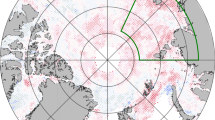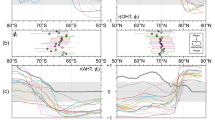Abstract
Various measurements from the Surface Heat Flux of the Arctic Ocean (SHEBA) experiment have been combined to study structures and processes producing the onset and end of summer melt over Arctic sea ice. The analysis links the surface energy budget to free-troposphere synoptic variables, clouds, precipitation, and in-ice temperatures. The key results are (1) SHEBA melt-season transitions are associated with atmospheric synoptic events (2) onset of melt clearly occurs on May 28, while the end of melt is produced by a sequence of three atmospheric storm events over a 28-day period producing step-like reductions in the net surface energy flux. The last one occurs on August 22.; (3) melt onset is primarily due to large increases in the downwelling longwave radiation and modest decreases in the surface albedo; (4) decreases in the downwelling longwave radiation occur for all end-of-melt transition steps, while increases in surface albedo occur for the first two; (5) decreases in downwelling shortwave radiation contribute only to the first end-of-melt transition step; (6) springtime free-tropospheric warming preconditions the atmosphere–ice system for the subsequent melt onset; and (7) melt-season transitions also mark transitions in system responses to radiative energy flux changes because of invariant melt-season surface temperatures. The extensive SHEBA observations enable an understanding of the complex processes not available from other field program data. The analysis provides a basis for future testing of the generality of the results, and contributes to better physical understanding of multi-year analyses of melt-season trends from less extensive data sets.

















Similar content being viewed by others
Notes
Because the range of dates for the SHEBA data is from October 1997, to October 1998, dates are designated by the day of year starting on Jan. 1, 1997, using YDxxx. For example, Jan. 1, 1998, is denoted by YD366.
References
Alt BT (1987) Developing synoptic analogs for extreme mass balance conditions on Queen Elizabeth Island ice caps. J Clim Appl Meteor 26:1605–1623
Andreas EL, Ackley S (1982) On the differences in ablation seasons of Arctic and Antarctic sea ice. J Atmos Sci 39:440–447
Birch CE, Brooks IM, Tjernström M, Milton SF, Earnshaw Söderberg PS, Persson POG (2009) The performance of a global and mesoscale model over the central Arctic Ocean during late summer. J Geophys Res 114:D13104. doi:10.1029/2008JD010790
Bitz CM, Batisti DS, Moritz RE, Beesley JA (1996) Low-frequency variability in the Arctic atmosphere, sea ice, and upper-ocean climate system. J Clim 9:394–408
Bohren CF, Barkstrom BR (1974) Theory of optical properties of snow. J Geophys Res 79(30):4527–4535
Colony R, Appel I, Rigor I (1992) Surface air temperature observations in the Arctic Basin. Tech. Memo. TM 1–92. Applied Physics Laboratory, University of Washington, Seattle (Available from Applied Physics Laboratory, University of Washington, Seattle, WA 98195)
Ebert EE, Curry JA (1993) An intermediate one-dimensional thermodynamic sea-ice model for investigating ice-atmosphere interactions. J Geophys Res 98:10085–10109
Grachev AA, Andreas EL, Fairall CW, Guest PS, Persson POG (2007) The SHEBA profile functions in the stable atmospheric boundary layer. Boundary Layer Meteorol 124(3):315–333. doi:10.1007/s10546-007-9177-6
Grenfell TC, Perovich DK (2004) Seasonal and spatial evolution of albedo in a snow-ice-land-ocean environment. J Geophys Res 109:C01001. doi:10.1029/2003JC001866
Hinzman LD, Bettez ND, Bolton WR, Chapin FS, Dyurgerov MB, Fastie CL, Griffith B, Hollister RD, Hope A, Huntington HP, Jensen AM, Jia GJ, Jorgenson T, Kane DL, Klein DR, Kofinas G, Lynch AH, Lloyd AH, McGuire AD, Nelson FE, Oechel WC, Osterkamp TE, Racine CH, Romanovsky VE, Stone RS, Stow DA, Sturm M, Tweedie CE, Vourlitis GL, Walker MD, Walker DA, Webber PJ, Welker JM, Winker KS, Yoshikawa K (2005) Evidence and implications of recent climate change in Northern Alaska and other Arctic regions. Climatic Change [Clim Change] 72(3): 251–298
Holmgren B (1971) Climate and energy exchange on a Subpolar ice cap in summer. Part F: on the energy exchange of the snow surface at ice cap station. Uppsala Universitet, Meteorlogiska Institutionen, Meddelande Nr. 111
Inoue J, Kosovic B, Curry JA (2005) Evolution of a storm-driven boundary layer in the Arctic. Boundary Layer Meteorol 117:213–230. doi:10.1007/s10546-004-6003-2
Intrieri J, Fairall CW, Shupe MD, Persson POG, Andreas EL, Guest PS, Moritz RE (2002a) Annual cycle of Arctic surface cloud forcing at SHEBA. J Geophys Res 107(C10):8039. doi:10.1029/2000JC000439
Intrieri J, Shupe MD, Uttal T, McCarty BJ (2002b) An annual cycle of cloud characteristics observed by radar and lidar at SHEBA. J Geophys Res 107(C10):8039. doi:10.1029/2000JC000423
Laxon S, Peacock N, Smith D (2003) High interannual variability of sea ice thickness in the Arctic region. Nature 42:947–949. doi:10.1038/nature02050
Light B, Grenfell TC, Perovich DK (2008) Transmission and absorbtion of solar radiation by Arctic sea ice during the melt season. J Geophys Res 113:C03023. doi:1029/2006JC003977
Lilljequist GH (1956) Energy exchange of an antarctic snow-field, shortwave radiation (Maudheim 70°03′S, 10°56′W), Norwegian-British-Swedish Antarctic Expedition, 1949–1952, Scientific Results, 2, part IA, Norsk Polarinstitutt, Oslo
Lindsay RW (1998) Temporal variability of the energy balance of thick Arctic pack ice. J Clim 11:313–333
Markus T, Stroeve JC, Miller J (2009) Recent changes in Arctic sea ice melt onset, freezeup, and melt season length. J Geophys Res 114:C12024. doi:10.1029/2009JC005436
Maykut GA (1982) Large-scale heat exchange and ice production in the Central Arctic. J Geophys Res 87:7971–7984
Morrison H, Zuidema P, Ackerman AS, Avramov A, de Boer G, Fan J, Fridlind AM, Hashino T, Harrington JY, Luo Y, Ovchinnikov M, Shipway B (2011) Intercomparison of cloud model simulations of Arctic mixed-phase boundary layer clouds observed during SHEBA. J Adv Model Earth Sys 3:M06003 doi:10.1029/2011MS000066
Overland JE (2009) Meteorology of the Beaufort Sea. J Geophys Res 114:C00A07. doi:10.1029/2008JC004861
Overland JE, Wang M (2010) Large-scale atmospheric circulation changes associated with the recent loss of Arctic sea ice. Tellus 62A:1–9
Perovich DK (2005) On the aggregate-scale partitioning of solar radiation in Arctic sea ice during the Surface Heat Budget of the Arctic Ocean (SHEBA) field experiment. J Geophys Res 110:C03002. doi:10.1029/2004JC002512
Perovich D, Andreas EL, Curry J, Eiken H, Fairall C, Grenfell T, Guest P, Intrieri J, Kadko D, Lindsay R, McPhee M, Morison J, Moritz R, Paulson C, Pegau S, Persson O, Pinkel R, Richter-Menge J, Stanton T, Stern H, Sturm M, Tucker W, Uttal T (1999) Year on ice gives climate insights. EOS Trans Am Geophys Union 80(41):481–486
Perovich DK, Grenfell TC, Light B, Hobbs PV (2002) Seasonal evolution of the albedo of multiyear Arctic sea ice. J Geophys Res 107(C10):8044. doi:10.1029/2000JC000438
Perovich DK, Grenfell TC, Richter-Menge JA, Light B, Tucker WB III, Eicken H (2003) Thin and thinner: sea ice mass balance measurements during SHEBA. J Geophys Res 108(C3):8050. SHE 26-1–26-21. doi:10.1029/2001JC001079
Perovich DK, Nghiem SV, Markus T, Schweiger A (2007) Seasonal evolution and interannual variability of the local solar energy absorbed by the Arctic sea ice-ocean system. J Geophys Res 112:C03005. doi:10.1029/2006JC003558
Persson POG, Uttal T, Intrieri JM, Fairall CW, Andreas EL, Guest PS (1999) Observations of large thermal transitions during the Arctic night from a suite of sensors at SHEBA. Preprints, 3rd symposium on integrated observing systems., Jan. 10–15, 1999, Dallas, TX, 171–174
Persson POG, Fairall CW, Andreas EL, Guest PS, Perovich DK (2002) Measurements near the Atmospheric Surface Flux Group tower at SHEBA: near-surface conditions and surface energy budget. J Geophys Res 107(C10):8045. doi:10.1029/2000JC000705
Persson POG, Andreas EL, Fairall CW, Guest PS, Perovich DK (2003) Pack ice surface energy changes at SHEBA initiated by late summer synoptic forcing. Preprints, seventh conference on polar meteorology and oceanography and joint symposium on high-latitude climate variations, Hyannis, Mass., 12–16 May (Paper 3.21 on CD)
Rigor IG, Colony RL, Martin S (2000) Variations in surface air temperature observations in the Arctic, 1979–1997. J Clim 13:896–914
Ruffieux DR, Persson POG, Fairall CW, Wolfe DE (1995) Ice pack and lead surface energy budgets during LEADEX 92. J Geophys Res 100(C3):4593–4612
Serreze MC, Barrett AP (2011) Characteristics of the Beaufort Sea high. J Clim 24:159–182
Sharp M, Wang L (2009) A five-year record of summer melt on Eurasian Arctic ice caps. J Clim 22:133–145. doi:10.1175/2008JCLI2425.1
Shupe MD, Intrieri JM (2004) Cloud radiative forcing of the Arctic surface: the influence of cloud properties, surface albedo, and solar zenith angle. J Clim 17:616–628
Smith DM (1998) Recent increase in the length of the melt season of perennial Arctic sea ice. Geophys Res Lett 25:655–658
Steffen K, DeMaria T (1996) Surface energy fluxes of Arctic winter sea ice in Barrow Strait. J Appl Meteorol 35:2067–2079
Stone RS (1997) Variations in western Arctic temperatures in response to cloud radiative and synoptic-scale influences. J Geophys Res 102(D18):21769–21776
Stone RS, Dutton EG, Harris JM, Longenecker D (2002) Earlier spring snowmelt in northern Alaska as an indicator of climate change. J Geophys Res 107(D10):4089. doi:10.1029/2000JD000286
Sturm M, Perovich DK, Holmgren J (2002a) Thermal conductivity and heat transfer through the snow on the ice of the Beaufort Sea. J Geophys Res 107(C21):8043. SHE 23-1–SHE 23-17. doi:10.1029/2000JC000409
Sturm M, Holmgren J, Perovich DK (2002) Winter snow cover on the sea ice of the Arctic Ocean at the Surface Heat Budget of the Arctic OCean (SHEBA): temporal evolution and spatial variability. J Geophys Res 107(C10): 8047. SHE 19-1–SHE 19-17. doi:10.1029/2000JC000400
Uttal T, Curry JA, McPhee MG, Perovich DK, Moritz RE, Maslanik JA, Guest PS, Stern HL, Moore JA, Turenne R, Heiberg A, Serreze MC, Wylie DP, Persson POG, Paulson CA, Halle C, Morison JH, Wheeler PA, Makshtas A, Welch H, Shupe MD, Intrieri JM, Stamnes K, Lindsey RW, Pinkel R, Pegau WS, Stanton TP, Grenfell TC (2002) The surface heat budget of the Arctic. Bull Amer Meteor Soc 83:255–275
van den Broeke M, Bamber J, Ettema J, Rignot E, Schrama E, van de Berg WJ, van Meijgaard E, Velicogna I, Wouters B (2009) Partitioning recent Greenland mass loss. Science 326(5955):984–986
Wang L, Sharp MJ, Rivard B, Marshall S, Burgess D (2005) Melt season duration on Canadian Arctic ice caps, 2000–2004. Geophys Res Lett 32:L19502. doi:10.1029/2005GL023962
Westwater ER, Han Y, Shupe MD, Matrosov SY (2001) Analysis of integrated cloud liquid and precipitable water vapor retrievals from microwave radiometers during SHEBA. J Geophys Res 106:32019–32030
Wylie DP (2001) Arctic weather during the FIRE/ACE flights in 1998. J Geophys Res 106(D14):15363–15375
Zhang T, Stamnes K, Bowling SA (1996) Impact of clouds on surface radiative fluxes and snowmelt in the Arctic and subarctic. J Clim 9:2110–2123
Zhang X, Walsh JE, Zhang J, Bhatt US, Ikeda M (2004) Climatology and interannual variability of Arctic cyclone activity: 1948–2002. J Clim 17:2300–2317
Zuidema P, Baker B, Han Y, Intrieri J, Key J, Lawson P, Matrosov S, Shupe M, Stone R, Uttal T (2005) An Arctic springtime mixed-phase cloudy boundary layer observed during SHEBA. J Atmos Sci 62:160–176
Acknowledgments
The author wishes to acknowledge the hard, dedicated work provided by the numerous members of the SHEBA science team and project staff. The data collected by the Atmospheric Surface Flux Group (E. Andreas, C. Fairall, P. Guest, and numerous staff) provided the principal data set for this study. A. Grachev contributed useful additional processing of the turbulent flux data. Other groups contributing significant data include the Ice Physics Group (D. Perovich and T. Grenfell), the cloud remote sensing group (T. Uttal, J. Intrieri, M. Shupe), the SHEBA Project Office (R. Moritz), and the Atmospheric Radiation Measurement (ARM) group. This work was supported by the National Science Foundation under grants OPP-97-01766, ARC0714053, and ARC1023366. Collection of some of the data used was also supported by the US Department of Energy Atmospheric Radiation Measurement Program. Clarity was improved by recommendations from two anonymous reviewers.
Author information
Authors and Affiliations
Corresponding author
Rights and permissions
About this article
Cite this article
Persson, P.O.G. Onset and end of the summer melt season over sea ice: thermal structure and surface energy perspective from SHEBA. Clim Dyn 39, 1349–1371 (2012). https://doi.org/10.1007/s00382-011-1196-9
Received:
Accepted:
Published:
Issue Date:
DOI: https://doi.org/10.1007/s00382-011-1196-9




